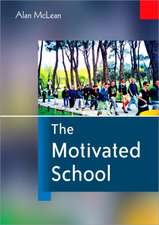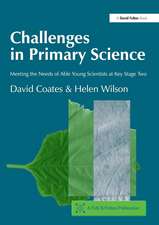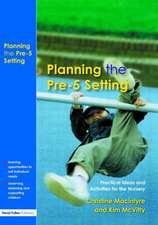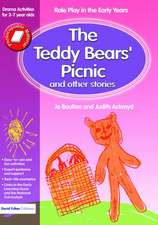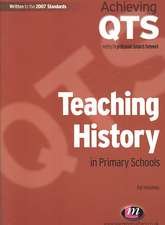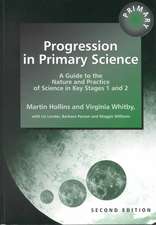Language Arts: Integrating Skills for Classroom Teaching
Autor Mildred R. Donoghueen Limba Engleză Paperback – 16 sep 2008
Preț: 977.93 lei
Preț vechi: 1339.63 lei
-27% Nou
Puncte Express: 1467
Preț estimativ în valută:
187.21€ • 192.54$ • 155.31£
187.21€ • 192.54$ • 155.31£
Carte tipărită la comandă
Livrare economică 19 februarie-05 martie
Preluare comenzi: 021 569.72.76
Specificații
ISBN-13: 9781412940498
ISBN-10: 1412940494
Pagini: 480
Dimensiuni: 203 x 254 x 19 mm
Greutate: 0.86 kg
Ediția:1
Editura: SAGE Publications
Colecția Sage Publications, Inc
Locul publicării:Thousand Oaks, United States
ISBN-10: 1412940494
Pagini: 480
Dimensiuni: 203 x 254 x 19 mm
Greutate: 0.86 kg
Ediția:1
Editura: SAGE Publications
Colecția Sage Publications, Inc
Locul publicării:Thousand Oaks, United States
Recenzii
"The pedagogical features are outstanding. Each one helps the reader understand the content and make connections to authentic teaching situations. The ideas are practical and helpful because they can be easily implemented in the classroom."
"Language Arts: Integrating Skills for Classroom Teaching supports teachers of language arts by providing a wealth of valuable resources, including sample lesson plans, instructional materials, recommendations for quality children’s literature, detailed descriptions of teaching strategies, and suggestions for meeting the needs of English language learners. The vignettes capture an authentic insider’s view on chapter topics; and together with the many resources, forge a connection between the theoretical and research base and the practical application of concepts."
"[The instructors' resources] are all nice features. As an instructor, having access to sample test questions, particularily ones that are similar to what students will experience on the PRAXIS tests are essential."
"I really love this textbook. It has great coverage, is reader friendly, and has a great approach to integration."
"I like the easy read style, with anecdotes, lesson plans, charts and tables."
"Instructor’s resources were helpful. The book is up-to-date and comprehensive."
The book is excellent and the difference in the price of this book and the text I have been using is about 50% less. I have known of Donoghue’s writing of Language Arts Texts for a number of years and find that she is always up-to-date on this subject area. Her current book is excellent!
"Language Arts: Integrating Skills for Classroom Teaching supports teachers of language arts by providing a wealth of valuable resources, including sample lesson plans, instructional materials, recommendations for quality children’s literature, detailed descriptions of teaching strategies, and suggestions for meeting the needs of English language learners. The vignettes capture an authentic insider’s view on chapter topics; and together with the many resources, forge a connection between the theoretical and research base and the practical application of concepts."
"[The instructors' resources] are all nice features. As an instructor, having access to sample test questions, particularily ones that are similar to what students will experience on the PRAXIS tests are essential."
"I really love this textbook. It has great coverage, is reader friendly, and has a great approach to integration."
"I like the easy read style, with anecdotes, lesson plans, charts and tables."
"Instructor’s resources were helpful. The book is up-to-date and comprehensive."
The book is excellent and the difference in the price of this book and the text I have been using is about 50% less. I have known of Donoghue’s writing of Language Arts Texts for a number of years and find that she is always up-to-date on this subject area. Her current book is excellent!
Cuprins
PART I. FOUNDATIONS OF THE LANGUAGE ARTS
1. Language and the English Language Arts
The Standards for the English Language Arts
Language Arts: Components/Integration
Functions and Characteristics of Language
Language Structure
Language and Thought
Assessment
Working With English Language Learners
Practical Instructional Activities and Ideas
Integration Across the Curriculum
Parents as Partners
Additional Professional Readings
Children?s Literature Cited in the Narrative
References
2. Children as Language Learners and Thinkers
Models of Natural Language Learning
First-Language Acquisition
Second-Language Acquisition
Linguistically Diverse Learners
Positive Language Classroom Environments
Assessment
Working With English Language Learners
Practical Instructional Activities and Ideas
Integration Across the Curriculum
Parents as Partners
Additional Professional Readings
Children?s Literature Cited in the Narrative
References
3. Formal and Authentic Assessment
Principles and Purposes of the Assessment of the Language Arts
Formal Assessment: Standardized Testing
Authentic Assessment: What, Why, and How
Authentic Assessment: Grading
Assessment
Working With English Language Learners
Practical Instructional Activities and Ideas
Integration Across the Curriculum
Parents as Partners
Additional Professional Readings
Children?s Literature Cited in the Narrative
References
4. Integrating Language Arts Across Curriculum
Integration: Definition, Principles, and Benefits
Thematic Units: Overview
Constructing a Thematic Unit
Implementing a Thematic Unit
Assessment
Working With English Language Learners
Practical Instructional Activities and Ideas
Integration Across the Curriculum
Parents as Partners
Additional Professional Readings
Children?s Literature Cited in the Narrative
References
PART II. READING AS A LANGUAGE ART
5. Word Recognition Skills and Vocabulary Development
Word Recognition Skills
Vocabulary Development
Assessment
Working With English Language Learners
Practical Instructional Activities and Ideas
Integration Across the Curriculum
Parents as Partners
Additional Professional Readings
Children?s Literature Cited in the Narrative
References
6. Reading: Principles, Approaches, Comprehension, and Fluency
Principles of Teaching Reading
Emergent Reading
Major Instructional Approaches
Models of Reading
Guided Reading
Comprehension: Categories and Influential Factors
Comprehension Strategies
Questioning: A Critical Comprehension Strategy
Sorting Out Comprehension ?Problems?
Reading in the Content Areas
Fluency
Assessment
Working With English Language Learners
Practical Instructional Activities and Ideas
Integration Across the Curriculum
Parents as Partners
Additional Professional Readings
Children?s Literature Cited in the Narrative
References
7. Reading and Children?s Literature
Literature in Elementary Education: Values and Functions
What Literature Does for Readers and Writers
Children?s Needs and Reading Interests
Criteria and Sources for Selecting Quality Books
Elements of Literature
Literature Genres
Bibliotherapy: Books That Help Children Cope
Living in a Diverse World: Multicultural Literature and International Literature
Instructional Activities
Literature Circles: A Popular Interpretive Activity
Assessment
Working With English Language Learners
Practical Instructional Activities and Ideas
Integration Across the Curriculum
Parents as Partners
Additional Professional Readings
Children?s Literature Cited in the Narrative
References
PART III. WRITING AS A LANGUAGE ART
8. Writing: Process, Genres, and Motivational Strategies
Guidelines for the Teaching of Writing
Factors Affecting Children?s Writing Performance
Emergent Writing
Abilities Needed for Effective Writing
The Writing Process
Writing Genres
Motivational Strategies That Promote Writing
Writing Development Through the Grades
Samples of Children?s Writing
Assessment
Working With English Language Learners
Practical Instructional Activities and Ideas
Integration Across the Curriculum
Parents as Partners
Additional Professional Readings
Children?s Literature Cited in the Narrative
References
9. Writing Tools: Handwriting, Keyboarding, Spelling, and Grammar
Handwriting and Keyboarding
Spelling
Grammar
Assessment
Working With English Language Learners
Practical Instructional Activities and Ideas
Integration Across the Curriculum
Parents as Partners
Additional Professional Readings
Children?s Literature Cited in the Narrative
References
10. The Writers? Workshop
Essentials of the Workshop
Implementing Writers? Workshop
First Major Component of the Workshop Session: Focus Lessons
Second Major Component of the Workshop Session: Independent Writing Time
Third Major Component of the Workshop Session: Share Time
Assessment
Working With English Language Learners
Practical Instructional Activities and Ideas
Integration Across the Curriculum
Parents as Partners
Additional Professional Readings
Children?s Literature Cited in the Narrative
References
PART IV. ORAL LANGUAGE ARTS
11. Listening and Speaking
Listening
Speaking
Assessment
Working With English Language Learners
Practical Instructional Activities and Ideas
Integration Across the Curriculum
Parents as Partners
Additional Professional Readings
Children?s Literature Cited in the Narrative
References
12. Creative Drama
Benefits of Creative Drama
Qualities and Components of Creative Drama
Major Types of Creative Drama
Assessment
Working With English Language Learners
Practical Instructional Activities and Ideas
Integration Across the Curriculum
Parents as Partners
Additional Professional Readings
Children?s Literature Cited in the Narrative
References
Appendix: Technology Connections for the Language Arts
Index
1. Language and the English Language Arts
The Standards for the English Language Arts
Language Arts: Components/Integration
Functions and Characteristics of Language
Language Structure
Language and Thought
Assessment
Working With English Language Learners
Practical Instructional Activities and Ideas
Integration Across the Curriculum
Parents as Partners
Additional Professional Readings
Children?s Literature Cited in the Narrative
References
2. Children as Language Learners and Thinkers
Models of Natural Language Learning
First-Language Acquisition
Second-Language Acquisition
Linguistically Diverse Learners
Positive Language Classroom Environments
Assessment
Working With English Language Learners
Practical Instructional Activities and Ideas
Integration Across the Curriculum
Parents as Partners
Additional Professional Readings
Children?s Literature Cited in the Narrative
References
3. Formal and Authentic Assessment
Principles and Purposes of the Assessment of the Language Arts
Formal Assessment: Standardized Testing
Authentic Assessment: What, Why, and How
Authentic Assessment: Grading
Assessment
Working With English Language Learners
Practical Instructional Activities and Ideas
Integration Across the Curriculum
Parents as Partners
Additional Professional Readings
Children?s Literature Cited in the Narrative
References
4. Integrating Language Arts Across Curriculum
Integration: Definition, Principles, and Benefits
Thematic Units: Overview
Constructing a Thematic Unit
Implementing a Thematic Unit
Assessment
Working With English Language Learners
Practical Instructional Activities and Ideas
Integration Across the Curriculum
Parents as Partners
Additional Professional Readings
Children?s Literature Cited in the Narrative
References
PART II. READING AS A LANGUAGE ART
5. Word Recognition Skills and Vocabulary Development
Word Recognition Skills
Vocabulary Development
Assessment
Working With English Language Learners
Practical Instructional Activities and Ideas
Integration Across the Curriculum
Parents as Partners
Additional Professional Readings
Children?s Literature Cited in the Narrative
References
6. Reading: Principles, Approaches, Comprehension, and Fluency
Principles of Teaching Reading
Emergent Reading
Major Instructional Approaches
Models of Reading
Guided Reading
Comprehension: Categories and Influential Factors
Comprehension Strategies
Questioning: A Critical Comprehension Strategy
Sorting Out Comprehension ?Problems?
Reading in the Content Areas
Fluency
Assessment
Working With English Language Learners
Practical Instructional Activities and Ideas
Integration Across the Curriculum
Parents as Partners
Additional Professional Readings
Children?s Literature Cited in the Narrative
References
7. Reading and Children?s Literature
Literature in Elementary Education: Values and Functions
What Literature Does for Readers and Writers
Children?s Needs and Reading Interests
Criteria and Sources for Selecting Quality Books
Elements of Literature
Literature Genres
Bibliotherapy: Books That Help Children Cope
Living in a Diverse World: Multicultural Literature and International Literature
Instructional Activities
Literature Circles: A Popular Interpretive Activity
Assessment
Working With English Language Learners
Practical Instructional Activities and Ideas
Integration Across the Curriculum
Parents as Partners
Additional Professional Readings
Children?s Literature Cited in the Narrative
References
PART III. WRITING AS A LANGUAGE ART
8. Writing: Process, Genres, and Motivational Strategies
Guidelines for the Teaching of Writing
Factors Affecting Children?s Writing Performance
Emergent Writing
Abilities Needed for Effective Writing
The Writing Process
Writing Genres
Motivational Strategies That Promote Writing
Writing Development Through the Grades
Samples of Children?s Writing
Assessment
Working With English Language Learners
Practical Instructional Activities and Ideas
Integration Across the Curriculum
Parents as Partners
Additional Professional Readings
Children?s Literature Cited in the Narrative
References
9. Writing Tools: Handwriting, Keyboarding, Spelling, and Grammar
Handwriting and Keyboarding
Spelling
Grammar
Assessment
Working With English Language Learners
Practical Instructional Activities and Ideas
Integration Across the Curriculum
Parents as Partners
Additional Professional Readings
Children?s Literature Cited in the Narrative
References
10. The Writers? Workshop
Essentials of the Workshop
Implementing Writers? Workshop
First Major Component of the Workshop Session: Focus Lessons
Second Major Component of the Workshop Session: Independent Writing Time
Third Major Component of the Workshop Session: Share Time
Assessment
Working With English Language Learners
Practical Instructional Activities and Ideas
Integration Across the Curriculum
Parents as Partners
Additional Professional Readings
Children?s Literature Cited in the Narrative
References
PART IV. ORAL LANGUAGE ARTS
11. Listening and Speaking
Listening
Speaking
Assessment
Working With English Language Learners
Practical Instructional Activities and Ideas
Integration Across the Curriculum
Parents as Partners
Additional Professional Readings
Children?s Literature Cited in the Narrative
References
12. Creative Drama
Benefits of Creative Drama
Qualities and Components of Creative Drama
Major Types of Creative Drama
Assessment
Working With English Language Learners
Practical Instructional Activities and Ideas
Integration Across the Curriculum
Parents as Partners
Additional Professional Readings
Children?s Literature Cited in the Narrative
References
Appendix: Technology Connections for the Language Arts
Index
Notă biografică
Mildred R. Donoghue is a Professor of Education and Reading at California State University, Fullerton. She teaches courses in the Multiple Subject Credential Program and in the Master¿s program in Elementary Curriculum and Instruction (emphasis: Early Childhood Education). She is a member of Alpha Upsilon Alpha Honor Society of the International Reading Association.
Donoghue has published nine books to date in the language/literacy field, the latest being Language Arts: Integrating Skills for Classroom Teaching (SAGE). She serves on the editorial review board of the Journal of Children¿s Literature (NCTE) and The Dragon Lode (IRA) and has established the Donoghue Children¿s Literature Center at the University Library at Cal State Fullerton. Her work as supervisor of elementary student teachers allows her to visit public classrooms and maintain currency in her preparations and writing.
Donoghue has published nine books to date in the language/literacy field, the latest being Language Arts: Integrating Skills for Classroom Teaching (SAGE). She serves on the editorial review board of the Journal of Children¿s Literature (NCTE) and The Dragon Lode (IRA) and has established the Donoghue Children¿s Literature Center at the University Library at Cal State Fullerton. Her work as supervisor of elementary student teachers allows her to visit public classrooms and maintain currency in her preparations and writing.

